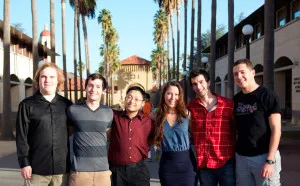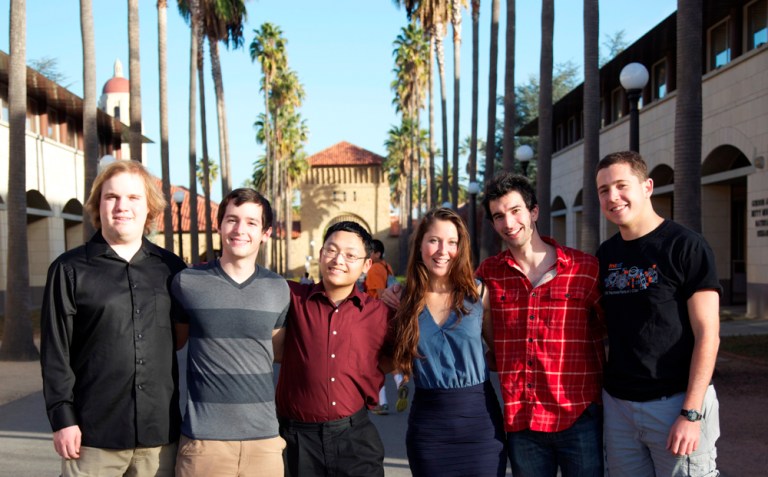
Paul Warren ’17 called up his teammates as soon as he heard the news.
With a team that includes five other Stanford students and two faculty advisers, Warren had spent five days in November rushing to complete a comprehensive, nearly 30-page proposal. If selected, the group would fly out to Houston and participate in a weeklong NASA program, which gives college undergraduates the opportunity to conduct an experiment aboard an airplane flight that imitates zero-gravity conditions.
Days into winter break, a NASA official phoned Warren to deliver its verdict.
“I actually ended up missing the call the first time,” Warren said.
Eventually, the two parties connected, and Warren didn’t take long to give the news to the rest of the group, including Sam Beder ’13 M.S. ’14.
“I was out with someone, and I literally started dancing in the street because you get this phone call saying that you get to experience zero gravity,” Beder said. “And I consider that the coolest thing ever.”
The team is the first in Stanford’s history to be chosen for NASA’s Reduced Gravity Student Flight Opportunities Program, Warren said. Its members will spend April 4-12 at the Johnson Space Center in Houston, testing to see whether a compact, user-friendly medical device will work in a zero gravity environment.
Currently, the team is attempting to scrounge up the funds to cover travel expenses. Beder said the group needs to amass at least $8,000-$12,000, but would like to raise even more in order to finance youth outreach events in surrounding communities.
Earlier this month, for instance, Warren spoke at a TEDx event at Gunn High School.
“It was nice,” Warren said about delivering the speech. “I obviously still get nervous and stuff, but I got to talk to 300 high schoolers, in front of faculty and community members, and people actually took me seriously.”
The mentor
Peter Lee, an assistant professor of cardiac surgery at Ohio State University, was not surprised at the Stanford team’s selection in December.
“I have to say I was pretty confident that [the team] would get accepted,” said Lee, who has led eight previous teams at Brown and Harvard to participate in the NASA program. “In terms of the interest that NASA would have … we really put together a serious proposal that would benefit the space program.”
A year ago, news broke that Lee, then a Stanford heart surgeon, had won a research competition. His joint proposal was to study weightlessness on the hearts of fruit flies in the International Space Center. Soon after, Stanford students started contacting Lee much more frequently, expressing interest in studying aeromedicine, he said.
He remembered several of these students when the deadline for NASA’s Reduced Gravity Student Flight Opportunities came around this November.
Lee said he thought the program would be a good opportunity to work with undergraduates as well as test a project that he had been mulling over the year prior.
Recognizing a limited ability to deal with medical emergencies in space, Lee thought about a piece of technology currently utilized in Intensive Care Units for real-life cardiac monitoring: the hemodynamic transesophageal echocardiogram (hTEE). The device is small and user-friendly, potentially perfect for astronauts on a long-duration space mission.
“[The hTEE] can be used with very little training: You get not as good, but reasonably good pictures of the heart, and so our proposal is basically to demonstrate that this smaller, miniaturized [device] can be inserted into a mannequin and give you good images of the heart and can be used for training,” Lee said.
Lee approached Warren and David Gerson ’14 M.S. ’14, a co-founder of the Stanford Student Space Initiative (SSI), with the idea of submitting a proposal to test the device in zero-gravity conditions.
“I love teaching and working with students,” Lee said about participating in the program for the ninth time. “Plus, it’s also being able to contribute to the space program.”
“Every experiment that we conduct that is successful and that we can publish, we add to the fount of knowledge that the space program can use as part of space exploration,” he added.
Democratizing space
After quickly rounding up a team through the SSI mailing list, Warren launched a five-day effort to churn out a proposal before the early November deadline. Many of the team members had never met each other previously and came from both the freshman and senior class.
“The team’s a lot of fun,” Gerson said. “Everyone brings a ton of energy. They are extremely hard-working, incredibly smart and really, really driven.”
“I mean we pulled the proposal together in five days. We were super excited and stayed up super late,” he added.
Warren, a freshman, is the team leader. He said his initial interest in space stemmed from his childhood love of Orson Scott Card’s novel “Ender’s Game.”
Now, the possibilities for democratizing space inspire him.
“When you talk about space missions, you talk about multimillion, multibillion space missions,” Warren said. “One thing we want to try to do here is try to make space available to everyone … It follows the Silicon Valley mindset of building a lot cheaply and making it accessible to a lot of people.”
Right now, the team is preparing — and excited — for their April flight.
“We actually have to build the thing, which isn’t actually that complicated,” Gerson said. “I think it’s more complicated figuring out how exactly we are going to put everything together: making a base, wiring some batteries, and then strapping the mannequin down and attaching the HD monitor.”
He added that the biggest challenge will be figuring out how exactly they will accomplish their goals and what they will do during the trip.
“But I’m excited for it,” Gerson said. “It’s going to be fun. Everyone who had been on a zero-g flight always talks about it … So I’m super stoked.”
Contact Kurt Chirbas at kchirbas ‘at’ stanford.edu.
